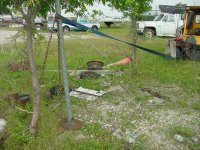wroughtn_harv
Super Member
I don't do much of that. Just no call for it around here I guess. But the other night I was thinking, character flaw.
But if I was in a situation where I had to pull a lot of stumps I think I'd try something.
Using a FEL works. But using it at or just beyond reasonalble capacity shortens it's life and is always dangerous.
The way the old boys did it was to place the chain or cable over a large wheel and then try to pull the stump up. The logic behind this is to lift up as you're pulling out.
The old boys didn't have those hellacious fiberglass straps we have today. I just had a bud give me two real big dogs, three and a half inches wide, half an inch thick with built in loop at each end. He says they're used at the docks for handling pipe etc. And they're rotated ever so often as a safety measure. He picks them up and then resells them to guys wanting tow straps or kicker slings.
So what I was thinking I'd try if'n I was in that situation would be to make a whatchamacallit.
A whozit if you will.
Let's say you take a twelve inch by twelve inch plate of half inch steel. On this plate you weld two ears with a hole in each. Let's say you weld them a inch apart. In between these two ears you place a piece of one inch by two inch by six inch plate with a matching hole. You have a hinge kind of thingy.
On the end of the one by two by six inch plate you weld a piece of two inch heavy wall tubing about four foot long. At the other end of this four foot long piece you attach a hook for a chain on one side and an eye for your fiberglass strap on the other.
The strap is attached to the tractor. I suspect a loose strap on the fly is a lot less deadly than a comparable chain. The chain is attached to the stump.
I'd say first pull would have the four foot piece at about a fifteen degree angle out over the stump. That way when the tractor is moved forward there is an upward movement on the chain and stump.
If the tractor bogs or the stump doesn't budge then I'd suggest a steeper angle for the first pull. The bigger bite will take more umph. And the shorter bite will take less. So if the umph is constant then the size of the bite is what decides to make something move. Sorta like the transmission in your tractor.
I just have to believe that any tractor that any of us would have access to can exert more force moving forward or backward than that it can muster with it's FEL.
But if I was in a situation where I had to pull a lot of stumps I think I'd try something.
Using a FEL works. But using it at or just beyond reasonalble capacity shortens it's life and is always dangerous.
The way the old boys did it was to place the chain or cable over a large wheel and then try to pull the stump up. The logic behind this is to lift up as you're pulling out.
The old boys didn't have those hellacious fiberglass straps we have today. I just had a bud give me two real big dogs, three and a half inches wide, half an inch thick with built in loop at each end. He says they're used at the docks for handling pipe etc. And they're rotated ever so often as a safety measure. He picks them up and then resells them to guys wanting tow straps or kicker slings.
So what I was thinking I'd try if'n I was in that situation would be to make a whatchamacallit.
A whozit if you will.
Let's say you take a twelve inch by twelve inch plate of half inch steel. On this plate you weld two ears with a hole in each. Let's say you weld them a inch apart. In between these two ears you place a piece of one inch by two inch by six inch plate with a matching hole. You have a hinge kind of thingy.
On the end of the one by two by six inch plate you weld a piece of two inch heavy wall tubing about four foot long. At the other end of this four foot long piece you attach a hook for a chain on one side and an eye for your fiberglass strap on the other.
The strap is attached to the tractor. I suspect a loose strap on the fly is a lot less deadly than a comparable chain. The chain is attached to the stump.
I'd say first pull would have the four foot piece at about a fifteen degree angle out over the stump. That way when the tractor is moved forward there is an upward movement on the chain and stump.
If the tractor bogs or the stump doesn't budge then I'd suggest a steeper angle for the first pull. The bigger bite will take more umph. And the shorter bite will take less. So if the umph is constant then the size of the bite is what decides to make something move. Sorta like the transmission in your tractor.
I just have to believe that any tractor that any of us would have access to can exert more force moving forward or backward than that it can muster with it's FEL.
